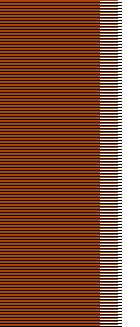

Studio Monitors (Reference Speakers)When you're going to choose studio monitors for your recording studio it's important to know that these monitors are not supposed to provide a rich audio experience, as you would expect from a hi-fi music system. These studio monitor speakers are designed to provide an accurate image of whatever sound source you are listening to, so you can hear exactly what is going on in your production. When you hear the phrases "flat frequency response" or "uncolored sound", this is what they mean. The speakers tell the "cold hard truth" about your mix. Studio monitors are also known as reference speakers, as that is exactly what they should provide. A reference sound. And that might be the most important point in choosing studio monitors. How they sound in reference to other sound systems.
People will be listening to your music on various sound systems, on small radios, in their car, on their $1000 hi-fi rig, and you want your music to sound good on all of the above. This is why an important part of mixing is to test and learn how the sound transfers to other systems, really get to know your speakers. Believe me, this has great impact on the end result of your mix.
Near-field studio monitorsNear-field or close-field monitors are the most common types of studio monitors, especially in home recording studios. They are designed for near field listening (sitting about 3 to 5 feet away). Listening at this distance will make poor room acoustics less important (as the sound hits your ears before bouncing off any other surfaces). This is great for a home recording studio since you probably haven't had an acoustic engineer designing your living room or bedroom.
An expression you may come across related to monitoring sound is "sweet spot". This is the spot exactly in the middle between the speakers, where you will hear the full stereo image. It might read in studio monitor descriptions that they have a "large sweet spot". This means that you can move your head around and still be able to hear the full stereo sound. This is also known as a "uniform off-axis response".
Close to all studio mixing is done with near-field studio speakers.
Find near field studio monitors at zZounds.com
Mid and Far-field monitorsThese monitors are usually not suitable at all for a home recording studio. These are larger and more expensive and demand an acoustically treated room to provide the proper reference sound.
Active vs. Passive monitorsYou also have to choose between active and passive speakers. Active speakers, a.k.a. powered or bi-amplified speakers, have a built in power amplifier inside its casing.
Unpowered/passive monitors do not. Active studio monitors have some advantages over passive ones. They save space, as they don't need that extra amplifier. The amp is matched to the speaker so you don't have to worry about your external amp not matching your speaker frequencies.
Just keep in mind that when choosing active monitors, each of them run on AC power.
Browse active or passive studio monitors at zZounds.com
Studio Speaker placementThis is very important, as it can have great impact on your monitors ability to perform right.
I know there are lots and lots of discussions on how to do this. The pros and semi-pros treat this part as a science. This is just a brief general description of how I do it.
Browse speaker stands from zZounds.com
Most Importantly.....I believe that getting to know your speakers is the best way to be successful. Spend some time and learn how it sounds in reference to other systems, then you can act accordingly when changing your mix.
My recommendation in studio monitors:
Behringer B2031A Truth Active Monitors
|
|||
|
All content and images, except where noted are Copyright
2004-2009 Build-a-recording-studio.com. Content and images from affiliates are copyright to their respective owners. This site is in affiliation with and is powered by
|

